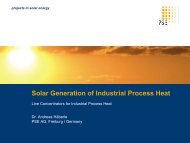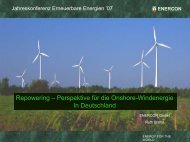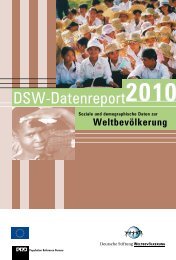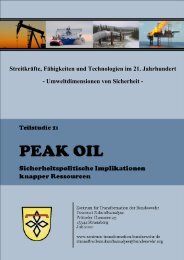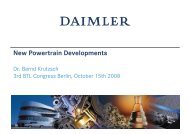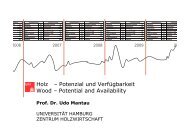Polymeric materials for solar thermal collectors â a feasibility study
Polymeric materials for solar thermal collectors â a feasibility study
Polymeric materials for solar thermal collectors â a feasibility study
You also want an ePaper? Increase the reach of your titles
YUMPU automatically turns print PDFs into web optimized ePapers that Google loves.
<strong>Polymeric</strong> <strong>materials</strong> <strong>for</strong> <strong>solar</strong> <strong>thermal</strong> <strong>collectors</strong><br />
– a <strong>feasibility</strong> <strong>study</strong><br />
Michael Köhl, Hannes Franke, Eva Stricker,<br />
Karl-Anders Weiß<br />
Fraunhofer-Institut für<br />
Solare Energiesysteme ISE<br />
ESTEC 2007<br />
Freiburg, 20.06.2007
Growing markets <strong>for</strong> <strong>solar</strong> <strong>thermal</strong> <strong>collectors</strong><br />
Improved public sympathy <strong>for</strong> renewable energies<br />
• Worldwide growth of market<br />
• Classical collector with copper absorber:<br />
• ~16,5 kg copper per 1MWh/year needed<br />
• to reach 1% of human energy consumption:<br />
22mill tons of copper needed: > total yearly production<br />
=> Alternative technologies needed<br />
⇒ <strong>Polymeric</strong> <strong>materials</strong> <strong>for</strong> absorbers and <strong>collectors</strong><br />
⇒ International cooperation: IEA SHCP<br />
KAW 20.6.2007<br />
2
Polymers – features and challenges<br />
• Light-weight <strong>materials</strong><br />
• Great freedom in design<br />
• Low cost processing technologies<br />
- Low intrinsic <strong>thermal</strong> conductivity<br />
- Limited weatherability<br />
=> Additives needed to improve stability and processability<br />
KAW 20.6.2007<br />
3
Polymers – material classes<br />
Per<strong>for</strong>mance<br />
KAW 20.6.2007<br />
4
Processing<br />
• Extrusion<br />
• Continuous<br />
• Restricted freedom of design<br />
• Co-extrusion possible<br />
• Injection moulding<br />
• Discontinuous, one step manufacturing<br />
• Highest mould costs<br />
• Low costs at high quantities<br />
• Thermo<strong>for</strong>ming<br />
• Low mould and machine costs<br />
• Flexible manufacturing<br />
KAW 20.6.2007<br />
5
Simulation of fluid dynamics and temperature distribution<br />
• Finite Elements<br />
• COMSOL Multiphysics (FEMLAB)<br />
• 3D<br />
• Simulation of half tubes<br />
• Simulation of extrudable geometries<br />
• => Comparison of designs<br />
KAW 20.6.2007<br />
6
Geometry of Collector<br />
KAW 20.6.2007<br />
7
Parameters <strong>for</strong> simulation<br />
• Low flow collector<br />
• Fluid:<br />
• Polymer:<br />
• External temp:<br />
water<br />
PPO<br />
290K<br />
• Heat input: 800 W/m² (No calculation of absorption)<br />
KAW 20.6.2007<br />
8
Calculated geometries<br />
KAW 20.6.2007<br />
9
Example 1: geometry A<br />
Flow velocity<br />
Temperature distribution<br />
KAW 20.6.2007<br />
10
Example 2: geometry G<br />
Flow velocity<br />
Temperature distribution<br />
KAW 20.6.2007<br />
11
Example 3: geometry D<br />
Flow velocity<br />
Temperature distribution<br />
KAW 20.6.2007<br />
12
Temperature distribution and mechanical stress<br />
<strong>Polymeric</strong> plate with Al-layer and absorber coating<br />
Temperature distribution and de<strong>for</strong>mation<br />
Stress-distribution<br />
KAW 20.6.2007<br />
13
Conclusions<br />
• FEM-simulation seems to be a suitable tool <strong>for</strong> optimisation of the<br />
absorber design<br />
• Parallel calculation of fluid dynamics, temperature distribution and<br />
mechanics offers the simultaneous consideration of different impact<br />
factors like flow-rate, pressure, temperature, degradation<br />
• Mechanical strain resulting from pressure gradients, temperature<br />
gradients can be calculated besides flow-velocity and temperature<br />
distribution<br />
• Results could be validated with CFD-simulations<br />
• First results <strong>for</strong> the optimization of the absorber geometry could be<br />
achieved<br />
KAW 20.6.2007<br />
14
Outlook / Problems<br />
• International cooperation allows cooperative research and exploitation:<br />
IEA SHCP Task39<br />
•Material parameters <strong>for</strong> simulation are needed from industry<br />
• Complexity of total collector and meshing of thin layers (example 2:<br />
~43.600 elements, 600.000 degrees of freedom)<br />
• Parallel calculation of fluid dynamics, temperature distribution and<br />
mechanics<br />
• Implementation and comparison of optical properties of different<br />
absorber layers<br />
• Optimization of geometry to improve heat transfer<br />
KAW 20.6.2007<br />
15
Thank<br />
You<br />
<strong>for</strong><br />
Your<br />
Attention!<br />
KAW 20.6.2007<br />
16



